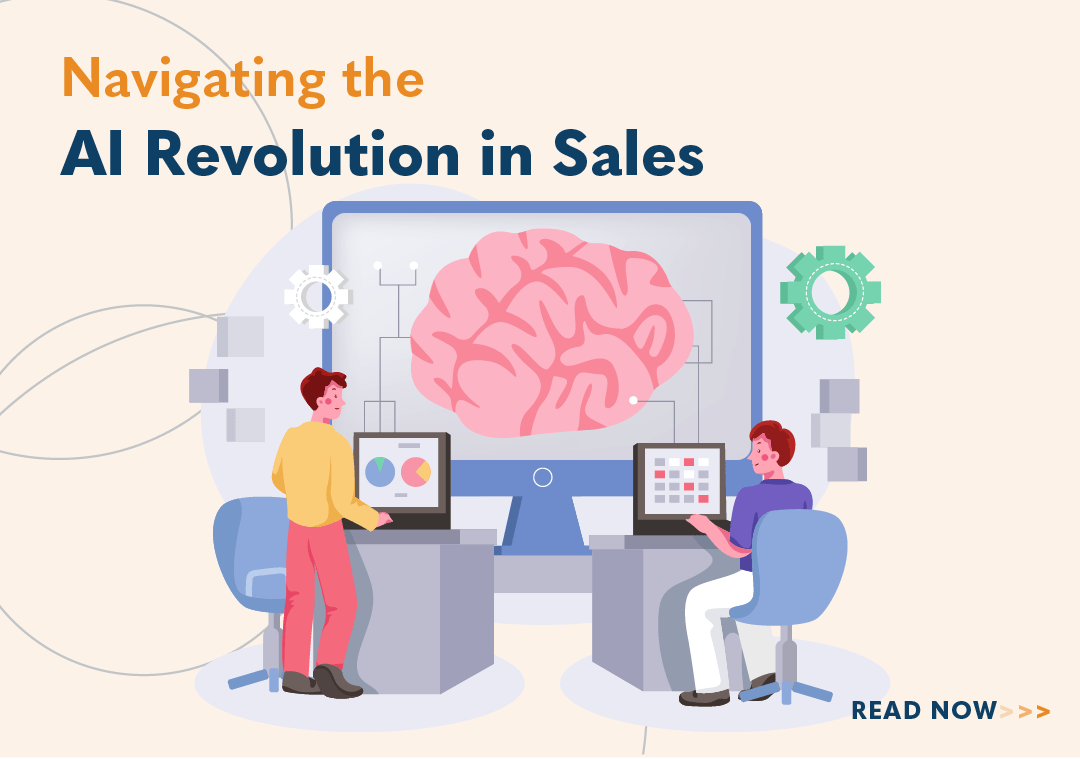Sales Leadership in 2024

From sales rep to managers to the C-suite, leaders embrace responsibility. Just as sales reps are responsible for their accounts, sales leaders assume all responsibility for their organizations. Leadership may start at the top, but it extends through your people and their processes. This includes forecasting, KPIs, and the bottom line. Our recent blog Sales Trends to Watch in 2024 examined what sales organizations should prepare for. Now, let’s explore how sales leaders can best enable their people and processes this year:
AI and Data-Driven Decision Making
For decision making, sales leaders have always relied on a mix of data and intuition. While this can be a complex and cumbersome endeavor, Artificial Intelligence can remove the guesswork. This makes it less magic and more science.
Gartner notes AI use is growing. They say, by 2025, 35 percent of CROs will utilize generative AI as part of their go-to-market organizations.
Plus, according to Invoca, this year, 93 percent of all marketers will invest in AI. Therefore, in 2024, a primary concern for sales leaders is ensuring their organizations are AI enabled. This includes:
- Harnessing the power of big data analytics to gain actionable insights
- Utilizing predictive analytics for more accurate sales forecasting
- Implementing AI-driven tools to identify patterns and optimize sales strategies
Today, AI can collect, process, and analyze more data in seconds. This gives sales leaders unprecedented access to higher quality information. Plus, AI quickly sifts through this data to determine the most accurate and relevant.
This means better, more pertinent information sales leaders—and sales teams—can act on more quickly. For example, web analytics give greater insights into your website visitors, what they seek, and what they need. In addition to improved conversion rates, it can refine campaigns to better understand customer behavior. This helps sales leaders enable their teams to better meet customer needs throughout the sales process.
AI also allows sales leaders to analyze past sales data and markets. This is essential to making informed predictions and decisions. More accurate forecasting means better preparation, less course correcting, and making changes faster, when needed. Overall, better use of your team’s time and resources.
In sales, outdated or incomplete data often means lost or missed opportunities. AI helps sales leaders quickly identify more accurate and relevant patterns in their data. This allows them to set realistic and achievable targets and goals for their teams.
Personalization at Scale
According to McKinsey, 71 percent of customers expect personalization. And 66 percent get frustrated without it. More importantly, 78 percent of customers are more likely to repeat purchases and refer companies that personalize.
This makes personalization essential to retaining established customers and attracting new ones. AI’s algorithms help sales leaders understand their customers. It can also provide deeper insight into their wants and needs. With these insights, sales organizations can:
- Customize sales approaches based on individual customer preferences
- Leverage AI and machine learning to deliver personalized content and recommendations
- Build stronger customer relationships through more tailored account management strategies
Of course, customer preferences are often dictated by age, gender, education, position, and other demographics. They can also be influenced by region, expertise, and experience.
While sales teams have always collected massive amounts of data in their CRMs, AI is not a stagnant tool. As more information is imported, leaders see better, real-time results. In addition, AI learns from the data it collects. This makes it easier to provide the personalized content and recommendations customers need. Also, as your customers’ needs change, so do your content and recommendations.
Thus, customers learn to trust sellers. When sales teams deliver highly customized, tailored solutions, they’re not just selling products. They’re building and reinforcing the relationships that turn customers into partners.
Hybrid Selling Models
Today, thirty-one percent of B2B sales reps agree face-to-face meetings are most effective. However, by 2025, Gartner expects 80 percent of sales interactions to take place digitally. In fact, 33 percent of buyers already expect a sales-free experience.
According to McKinsey, by 2024, shifts in customer preference will make hybrid the most dominant sales strategy.
From this, sales leaders must do more to enable remote and hybrid selling. For today’s increasingly hybrid sales teams, consider the following:
- Invite team participation in developing remote sales processes and strategies
- Balance traditional face-to-face sales with digital selling channels
- Integrate e-commerce platforms for a seamless buying experience
- Adapt sales strategies to cater to diverse customer preferences
Today’s sales teams are often as diverse as they are dispersed. All are not equally equipped to excel at hybrid selling. While many reps still feel in-person is best, it’s not always possible or feasible. Therefore, sales leaders must enable all reps to succeed. This starts with inviting sales rep participation and asking for their preferences and needs.
In addition, sales leaders should find the best mix of modes. This too can be a challenge. What’s best for one sales rep may not be best for another. Therefore, sales leaders must consider flexible schedules for remote/in-person sellers. In addition, they must enable sales reps to sell digitally. This includes content sharing, e-commerce, and mobile apps.
In most sales organizations, content lives in a central hub on their CRM. This is often easily accessed in a centralized office. However, it can become burdensome for remote or hybrid sales reps. Today, sales leaders must ensure remote/hybrid reps have easy access via smartphones and tablets.
In 2022, B2B e-commerce sales in the US grew by 19 percent. Of course, some of this was due to the pandemic. However, the trend is not slowing. With this, sales leaders must also enable e-commerce channels and digital tools, even in B2B sales environments. However, to maximize this potential, they must adapt to the changing needs of their customers. This means engaging their opinions. Start with your sales reps and gain their perspective but be sure to speak with clients and non-clients. Consider questionnaires and surveys to best understand your customers’ preferences.
Real-Time Collaboration Tools
HubSpot notes 29 percent of sales leaders prioritize collaboration. Further, research shows teamwork and collaboration increase sales by 27 percent. In addition, companies that promote collaboration perform five times better.
Obviously, the importance of collaboration cannot be overstated.
However, changing how we sell means updating how we communicate and collaborate. Four years ago, we first realized the realities of the pandemic. Those organizations equipped for virtual were prepared to sell virtually. Today, sales leaders must again ask about their tech stacks. As technology and modality changes, is your team enabled to collaborate and sell? Your organization must be prepared to:
- Utilize advanced collaboration tools for instant communication
- Streamline document sharing and project management for increased efficiency
- Enhance virtual teamwork to overcome geographical barriers
Your CRM is your most powerful sales tool. It’s a centralized location for all customer interactions across all channels. This makes it the nexus of a sales team’s collaboration efforts. As sales organizations become more tech centric, sales leaders must ensure the CRMs are up to today’s challenges.
Today, sales teams can connect AI to their CRMs to automate manual tasks. For example, HubSpot’s ChatSpot. This allows sales organizations to access more email data. Sales teams can accurately import company and contact information from spreadsheets to CRMs. This can eliminate inaccurate or duplicate data. Plus, this information is easily shared with all.
With hybrid selling, sales teams must keep up with mobile applications. This not only increases rep communication. It’s a vital tool for selling. In addition to website traffic, mobile app trackers provide insights into how customers use your mobile apps. Knowing their preferred conversation paths lets sales leaders maximize personalization for mobile users.
From messaging prospects to creating sales collateral, AI’s use as a writing tool is growing. Today, HubSpot notes 31 percent of sales reps already use generative AI to create content. Thus, to get in front of this trend, leaders must empower and enable sales teams with AI.
In addition, 71 percent of B2B companies use video in their marketing and sales endeavors. This includes product demos, how-tos, webinars, and testimonials. Today, AI can help sales teams leverage video to increase awareness, educate customers, and boost conversion rates. Plus, it increases departmental collaboration. It can better connect sales and marketing with L&D and product development.
Leadership is more than a title. Whether a sales rep, manager, or director, sales leaders embrace responsibility for their clients and their teams. As sales leaders welcome the challenges and opportunities of 2024, their ability to adapt is paramount.
By staying ahead of trends, sales leaders not only survive but thrive. This ensures sustained success for their organizations and customers. We hope this helps sales leaders better enable their teams for the coming year and beyond. For additional insights, see our blog Sales Trends to Watch in 2024.

- Account Planning (11)
- Awards (49)
- Client Testimonial (37)
- Personal Branding (19)
- Podcast (11)
- Research (70)
- Sales Career Development (87)
- Sales Coaching (156)
- Sales Consulting (137)
- Sales Culture (170)
- Sales Enablement (354)
- Sales Leadership (110)
- Sales Management (248)
- Sales Negotiation (16)
- Sales Prospecting (124)
- Sales Role-Playing (18)
- Sales Training (234)
- Selling Strategies (263)
- Soft Skills (70)
- Talent Management (94)
- Trusted Advisor (27)
- Virtual Selling (49)
- Webinar (9)


























